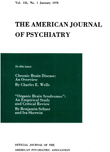HALLUCINATION AND IMAGERY INDUCED BY MESCALINE
Abstract
Mescaline produces altered visual experiences of several types, whose vividness and degree of distortion is proportionate to the size of the dose. There are no sharp boundaries dividing abnormal sensibility, illusions, and hallucinations. Subjects who gave fewer responses of the type "I see it" when asked to imagine situations were more likely to hallucinate than other patients. Visual responses declined still further after administration of mescaline in a degree more closely related to the amount of drug given than to the vividness of hallucinatory alterations, even in those experimental subjects who reported virtually no alteration in actual vision. The fall in reported visual imagery was not found in control subjects.
Access content
To read the fulltext, please use one of the options below to sign in or purchase access.- Personal login
- Institutional Login
- Sign in via OpenAthens
- Register for access
-
Please login/register if you wish to pair your device and check access availability.
Not a subscriber?
PsychiatryOnline subscription options offer access to the DSM-5 library, books, journals, CME, and patient resources. This all-in-one virtual library provides psychiatrists and mental health professionals with key resources for diagnosis, treatment, research, and professional development.
Need more help? PsychiatryOnline Customer Service may be reached by emailing [email protected] or by calling 800-368-5777 (in the U.S.) or 703-907-7322 (outside the U.S.).



